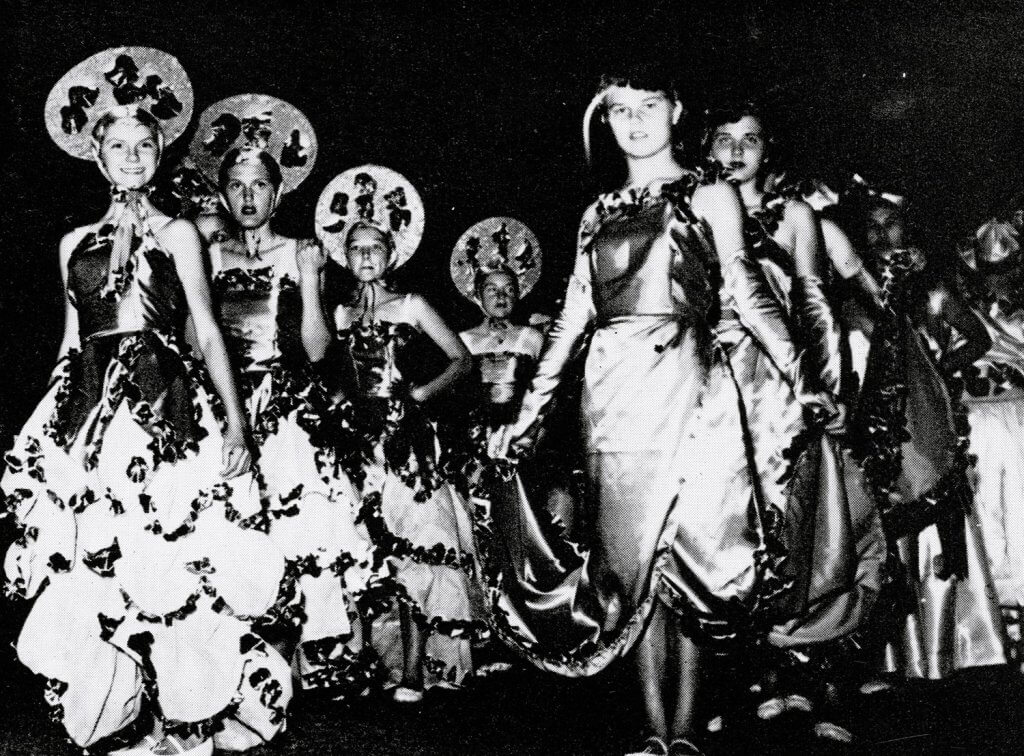For almost a quarter of a century, Arizona’s most prominent party was held every spring at Montgomery Stadium at the northeast corner of Seventh and Van Buren streets. From 1926-1955, the Masque of the Yellow Moon was the city’s hottest ticket, quickly selling out the 10,500-seat stadium.
But what exactly was this event that garnered so much attention? “The best description of the Masque I heard was that it was like a Super Bowl halftime show but without the football game,” Marshall Shore, Phoenix’s Hip Historian, says.
The event started in 1926 when the Phoenix Chamber of Commerce created a flower festival to promote their young city. In tune with the Roaring ’20s, the initial concept was super-sized into a week-long gala featuring band concerts, costume balls, and flower displays. The festival’s climax was a colossal pageant staged by thousands of students from Phoenix Union High School and Phoenix Junior College.

Phoenix Union High School students perform on the Montgomery Stadium field for the Masque of the Yellow Moon, 1953. (Photo: Phoenix Union High School)
The spectacle was called the Masque of the Yellow Moon after a Native American tradition of pausing during the full moon in spring to give thanks for prosperity. Sharlot Hall, who had been appointed Arizona’s Territorial Historian in 1905, wrote and directed the first production performed at Phoenix’s El Zaribah Shrine Auditorium at 15th Avenue and Washington Street.
The Masque became an annual event, adopting a different regional theme each year. Phoenix Union High School art teacher Claudia Perkins directed the pageant starting in 1927. The resulting production was a cavalcade of music, dance, and theater, culminating when the festival’s Queen was escorted to her throne.
However, problems were on the horizon when Perkins retired in 1954. What once was a Phoenix Union High School and Phoenix Junior College production now included six other Phoenix high schools. Participation had grown to an almost unmanageable 4,000 students and became even more challenging logistically.
Although unknown then, the final show was in 1955 and fittingly titled “Dawn, Noon, and Sunset in the Desert.” The production featured an old desert prospector reliving his memories, who, reflecting the times, declared, “They need lots of it [uranium] so’s they can blow one another up.”
The pageant officially died that fall. “Without a mourner in sight, the Masque of the Yellow Moon expired last night. The consensus of the Phoenix High School and College District board of trustees: The darn thing is just more trouble than it’s worth. The reaction of various school people assembled in the audience to the demise of the annual school-system play production: A sigh of relief,” stated an article in The Arizona Republic.

The “Desert Blooms” perform during the Masque of the Yellow Moon, 1955. (Photo: Phoenix Union High School)
Other forces were at play in ending the Masque. Phoenix was outgrowing its small-town roots, and entertainment options were expanding with the advent of television. For some, ending the pageant was controversial. High school classes later claimed newcomers to the city, who were lukewarm to the event, had sealed its fate.
A limited production featuring Phoenix Union High School alums, television personality Steve Allen, and high school students was performed at Civic Plaza in 1995. The occasion honored the original Masque and celebrated the school district’s 100th anniversary.



